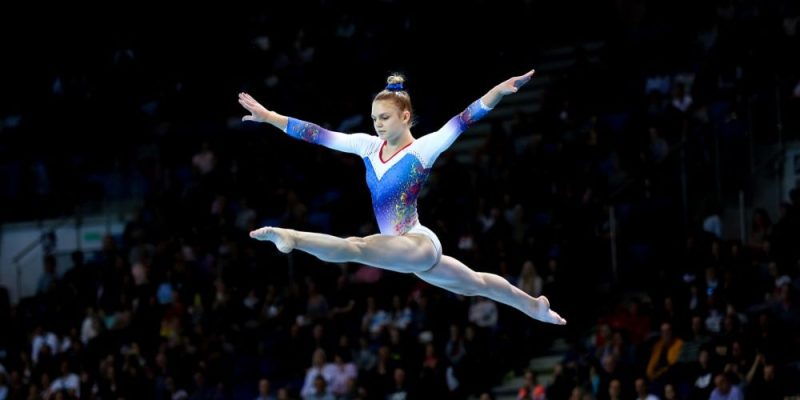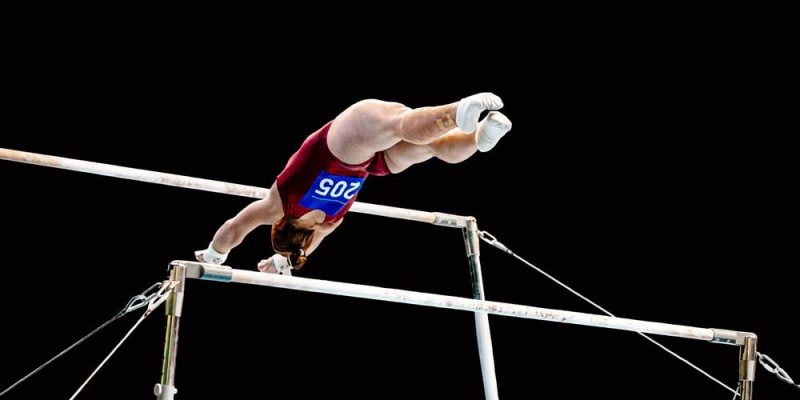We explain what artistic gymnastics is, its history and characteristics. In addition, we tell you what the devices he uses are like.

What is artistic gymnastics?
Artistic gymnastics (formerly Olympic gymnastics) is a sporting discipline, often considered a branch of gymnastics, whose practice consists of a series of rhythmic and acrobatic movements using different gymnastic devices, to demonstrate the flexibility, coordination, strength, balance and agility of the athlete. Practitioners of this discipline are known as gymnasts.
Unlike other forms of gymnastics, artistic gymnastics exercise aims to produce an aesthetic effect during the 30 to 90 seconds of movements involved That is, the movements are sought to be not only coordinated and correct, but also elegant, striking, and beautiful. Hence it is compared to an artistic practice.
This type of gymnastics is practiced by both men and women, either in groups or individually, and is part of the Olympic disciplines, that is, those that are practiced in the International Olympic Games every 4 years. The body that internationally regulates the practice of artistic gymnastics is the International Gymnastics Federation (FIG) based in Moutier, Switzerland.
See also: History of gymnastics
Characteristics of artistic gymnastics

In general, artistic gymnastics is characterized by the following:
- It is practiced by professional athletes, called gymnasts, in individual or group competitions for both the female and male gender. The most important competitions are part of the International Olympic Games (Olympic Games).
- Artistic gymnastics practices usually last between 30 seconds and a minute and a half and consist of a series of agile, coordinated and balanced movements on a surface of regulatory measurements, using gymnastic artifacts such as the uneven bars, the balance beam, the rack, the rings, the fixed bar, the pommel horse and the bars. parallels.
- The task of gymnasts is to perform movements in the most elegant, precise, coordinated and effective way possible. The aesthetic aspect is fundamental in the evaluation of these actions for which a format from 1 to 10 is used.
History of artistic gymnastics
The origins of gymnastics are remote in the history of humanity. The ancient Greeks already practiced it, as part of the military preparation of soldiers, and in times of peace for Olympic purposes.
However, The origin of artistic gymnastics itself dates back to the 19th century, specifically to 1811, and is due to Professor Friedrich Ludwig Jahn (1778-1852), from the German Institute in Berlin. Jahn created the first outdoor space for the practice of this discipline, and designed the first gymnastic equipment, from which the current ones are inspired.
The success of this new gymnastics spread in Germany and allowed the founding of various gymnastics clubs, which earned Jahn the title of “modern father of gymnastics.”
The consolidation of this sporting practice took place in 1881, with the founding of the European Gymnastics Federation, an organization that was later called the International Gymnastics Federation. This was a previous step for the acceptance of this sport in the first modern Olympic Games, held in Athens in 1896. At that time, artistic gymnastics and athletic competition formed a common unit.
Starting with the Amsterdam Olympics in 1928, women joined gymnastics competition. In 1952, artistic gymnastics was formalized as a rigorously sporting discipline, independent in all aspects. So much so, that In 1975, the Artistic Gymnastics World Cup was held for the first time.
gymnastic equipment

Current gymnastic equipment is inspired by the designs created by Jahn in the 19th century, and varies in the female and male categories, as follows:
Men's category devices:
- The rings. These are two rings with an internal diameter of 18 cm, which hang 2.75 meters from the ground, separated by a distance of 50 cm. Gymnasts must climb the apparatus and demonstrate their balance, strength and balance, doing different pirouettes. The less the ring strings shake, the better the score will be.
- The fixed bar. It is a bar 2.40 meters long, placed 2.80 meters from the ground on top of a metal structure, on which the gymnast must perform a series of acrobatics, demonstrating balance and strength. The score will be higher as long as the movements are organic and not improvised.
- The pommel horse. It is a device 1.15 meters high, 1.60 meters long and 35 cm wide, whose shape is reminiscent of a horse, on whose back there are two transverse rings. Holding onto the rings, the gymnast must perform circular and pendulum pirouettes with his legs, without interruptions and without touching the apparatus with his legs.
- The parallel bars. These are two parallel bars 3.5 meters long, suspended 1.75 meters high and separated by 42 centimeters, on which the gymnast must perform different strength exercises, such as handstands and full-body twists, holding on only with your hands.
- The pony jump. It is a 1.35 meter high device, located at the end of a 25 meter long track and next to a trampoline. The gymnast must gain momentum and jump the rack with the help of the springboard, keeping both feet together and resting both hands on the rack, in order to land two meters or more from the apparatus. For this you have two opportunities.
- The ground. This is the floor of the competition arena, covered with an elastic material forming a surface of 12 square meters. The gymnast has between 50 and 70 seconds to perform a series of gymnastic and acrobatic movements uninterruptedly.
Devices of the female category.
- The uneven bars. These are two bars suspended at different levels, one between 140 and 160 centimeters high, the other between 235 and 240 centimeters, separated by a distance of between 1 and 1.43 meters. The gymnasts must perform a set of pirouettes in 30 seconds moving between the two bars, building a pattern that culminates with a final acrobatic jump.
- The balance beam. It is a solid bar located 1.2 meters high, 10 centimeters wide and 5 meters long. On it, the gymnasts must perform a series of balance and agility acrobatics, having between 70 and 90 seconds. The qualification depends largely on the exercise looking as if it were performed on the floor and not on a narrow surface, for which it must be performed in an uninterrupted, harmonious and concatenated manner. If she falls from the bar, the gymnast has 10 seconds to return to her place and continue the exercise.
- The pony jump. It is the same device as in the men's category, arranged in the same way: 120 centimeters high, 35 centimeters wide and 160 centimeters long, located next to a trampoline at the end of a 25-meter long track.
- The ground. This is the floor, which is covered by an elastic material that protects against falls, over an area of 12 square meters. The gymnast has between 70 and 90 seconds to carry out a gymnastic routine with fluidity, grace and coordination, which usually includes somersaults and changes in direction and level of movement.
Modalities of artistic gymnastics
Artistic gymnastics is typically practiced in three different modalities:
- General individual competition. Where each gymnast demonstrates their skills on all of the available apparatus, and the score obtained on each one is added up to generate a general qualifying average.
- Individual device finals. Where the best gymnast is chosen in each specific apparatus, chosen from among the 8 best in the general individual competition, that is, those with the highest scores.
- Team competition. Where the gymnasts of each team must participate together. These teams are also chosen based on performance in the general individual competition.
Continue with: Individual sports
References
- “Artistic gymnastics” on Wikipedia.
- “Artistic gymnastics” at the International Olympic Committee.
- “Getting to know artistic gymnastics” (video) at CDAG Guatemala.
- “Artistic gymnastics” in The Encyclopaedia Britannica.





